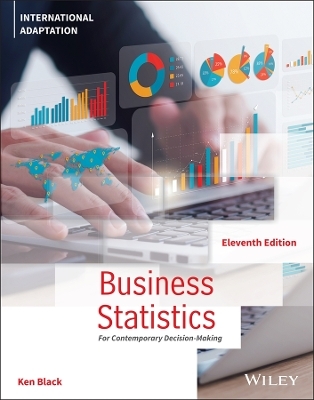
Business Statistics
John Wiley & Sons Inc (Verlag)
978-1-119-88966-3 (ISBN)
Continuing the tradition of presenting and explaining business statistics using clear, complete, and student-friendly pedagogy, this international edition includes new chapter cases reinforcing the vibrancy and relevance of statistics. In addition, topical changes have been made in select chapters and problems have been revised in all the chapters.
Ken Black is currently professor of quantitative management in the College of Business at the University of Houston–Clear Lake. Born in Cambridge, Massachusetts, and raised in Missouri, he earned a bachelor’s degree in mathematics from Graceland University, a master’s degree in math education from the University of Texas at El Paso, a Ph.D. in business administration (management science), and a Ph.D. in educational research from the University of North Texas. Since joining the faculty of UHCL in 1979, Professor Black has taught all levels of statistics courses, business analytics, forecasting, management science, market research, and production/operations management. He received the 2014 Outstanding Professor Alumni Award from UHCL. In 2005, he was awarded the President’s Distinguished Teaching Award for the university. He has published over 25 journal articles and 30 professional papers, as well as two textbooks: Business Statistics: An Introductory Course and Business Statistics for Contemporary Decision-Making.
1 Introduction to Statistics and Business Analytics
1.1 Basic Statistical Concepts
1.2 Data Measurement
1.3 Introduction to Business Analytics
2 Visualizing Data with Charts and Graphs
2.1 Frequency Distributions
2.2 Measures of Variability
2.3 Qualitative Data Graphs
2.4 Charts and Graphs for Two Variables
2.5 Visualizing Time-Series Data
3 Descriptive Statistics
3.1 Measures of Central Tendency
3.2 Measures of Variability
3.3 Measures of Shape
3.4 Business Analytics Using Descriptive Statistics
4 Probability
4.1 Introduction to Probability
4.2 Structure of Probability
4.3 Marginal, Union, Joint, and Conditional Probabilities
4.4 Addition Laws
4.5 Multiplication Laws
4.6 Conditional Probability
5 Discrete Random Variables and Their Probability
5.1 Discrete Random Variables
5.2 Describing a Discrete Distribution
5.3 Binomial Distribution
5.4 Poisson Distribution
5.5 Geometric Distribution
5.6 Hypergeometric Distribution
6 Continuous Random Variables and Normal Distributions
6.1 Continuous Random Variables
6.2 The Uniform Distribution
6.3 Normal Distribution
6.4 Using the Normal Curve to Approximate Binomial Distribution Problems
6.5 Exponential Distribution
7 Sampling Data and Decision Making
7.1 Sampling
7.2 Sampling Distribution of the Sample Mean
7.3 Sampling Distribution of a Sample Proportion
8 Statistical Inference: Estimation for Single Populations
8.1 Estimating the Population Mean Using the z Statistic (σ Known)
8.2 Estimating the Population Mean Using the t Statistic (σ Unknown)
8.3 Estimating the Population Proportion
8.4 Estimating the Population Variance
8.5 Estimating Sample Size
9 Statistical Inference: Hypothesis Testing for Single Populations
9.1 Introduction to Hypothesis Testing
9.2 Testing Hypotheses About a Population Mean Using the z Statistic (σ Known)
9.3 Testing Hypotheses About a Population Mean Using the t Statistic (σ Unknown)
9.4 Testing Hypotheses About a Proportion
9.5 Testing Hypotheses About a Variance
9.6 Solving for Type II Errors
10 Statistical Inference About Two Populations
10.1 Hypothesis Testing and Confidence Intervals About the Difference in Two Means Using the z Statistic (Population Variances Known)
10.2 Hypothesis Testing and Confidence Intervals About the Difference in Two Means: Independent Samples and Population Variances Unknown
10.3 Statistical Inferences for Two Related Populations
10.4 Statistical Inferences About Two Population Proportions, p1 − p2
10.5 Testing Hypotheses About Two Population Variances
11 Analysis of Variance and Design of Experiments
11.1 Introduction to Design of Experiments
11.2 The Completely Randomized Design (One-Way ANOVA)
11.3 Multiple Comparison Tests
11.4 The Randomized Block Design
11.5 A Factorial Design (Two-Way ANOVA)
12 Simple Regression Analysis and Correlation
12.1 Correlation
12.2 Introduction to Simple Regression Analysis
12.3 Determining the Equation of the Regression Line
12.4 Residual Analysis
12.5 Standard Error of the Estimate
12.6 Coefficient of Determination
12.7 Hypothesis Tests for the Slope of the Regression Model and Testing the Overall Model
12.8 Estimation
12.9 Using Regression to Develop a Forecasting Trend Line
12.10 Interpreting the Output
13 Multiple Regression Analysis
13.1 The Multiple Regression Model
13.2 Significance Tests of the Regression Model and Its Coefficients
13.3 Residuals, Standard Error of the Estimate, and R2
13.4 Interpreting Multiple Regression Computer Output
14 Building Multiple Regression Models
14.1 Nonlinear Models: Mathematical Transformation
14.2 Indicator (Dummy) Variables
14.3 Model-Building: Search Procedures
14.4 Multicollinearity
14.5 Logistic Regression
15 Time-Series Forecasting and Index Numbers
15.1 Introduction to Forecasting
15.2 Smoothing Techniques
15.3 Trend Analysis
15.4 Seasonal Effects
15.5 Autocorrelation and Autoregression
15.6 Index Numbers
16 Analysis of Categorical Data
16.1 Chi-Square Goodness-of-Fit Test
16.2 Contingency Analysis: Chi-Square Test of Independence
17 Nonparametric Statistics
17.1 Runs Test
17.2 Mann-Whitney U Test
17.3 Wilcoxon Matched-Pairs Signed Rank Test
17.4 Kruskal-Wallis Test
17.5 Friedman Test
17.6 Spearman’s Rank Correlation
18 Statistical Quality Control
18.1 Introduction to Quality Control
18.2 Process Analysis
18.3 Control Charts
19 Decision Analysis
19.1 Revision of Probabilities: Bayes’ Rule
19.2 The Decision Table and Decision-Making Under Certainty
19.3 Decision-Making Under Uncertainty
19.4 Decision-Making Under Risk
19.5 Revising Probabilities in Light of Sample Information
APPENDIX A
APPENDIX B
GLOSSARY
INDEX
| Erscheinungsdatum | 21.10.2022 |
|---|---|
| Verlagsort | New York |
| Sprache | englisch |
| Themenwelt | Wirtschaft ► Betriebswirtschaft / Management |
| ISBN-10 | 1-119-88966-9 / 1119889669 |
| ISBN-13 | 978-1-119-88966-3 / 9781119889663 |
| Zustand | Neuware |
| Haben Sie eine Frage zum Produkt? |
aus dem Bereich


